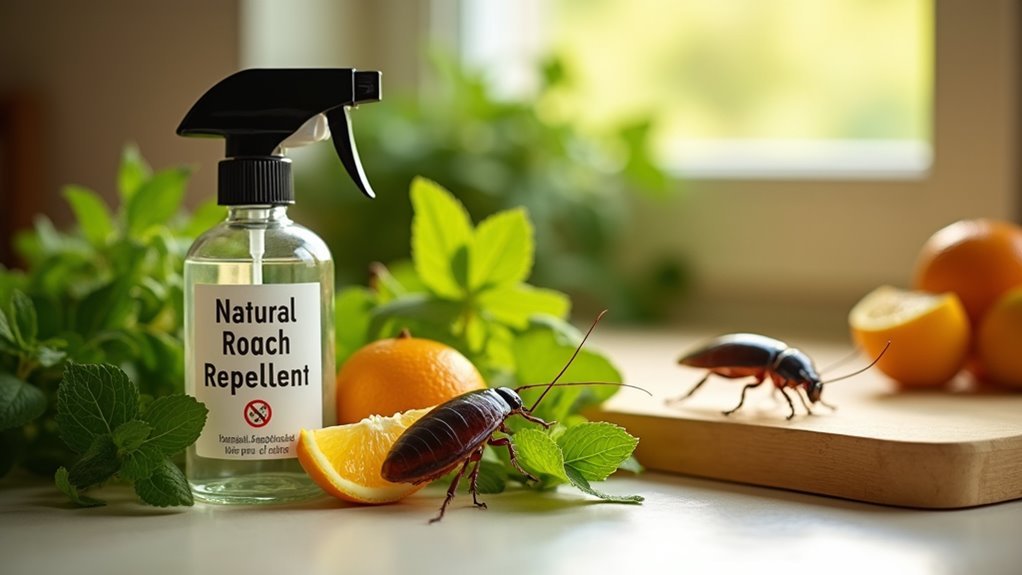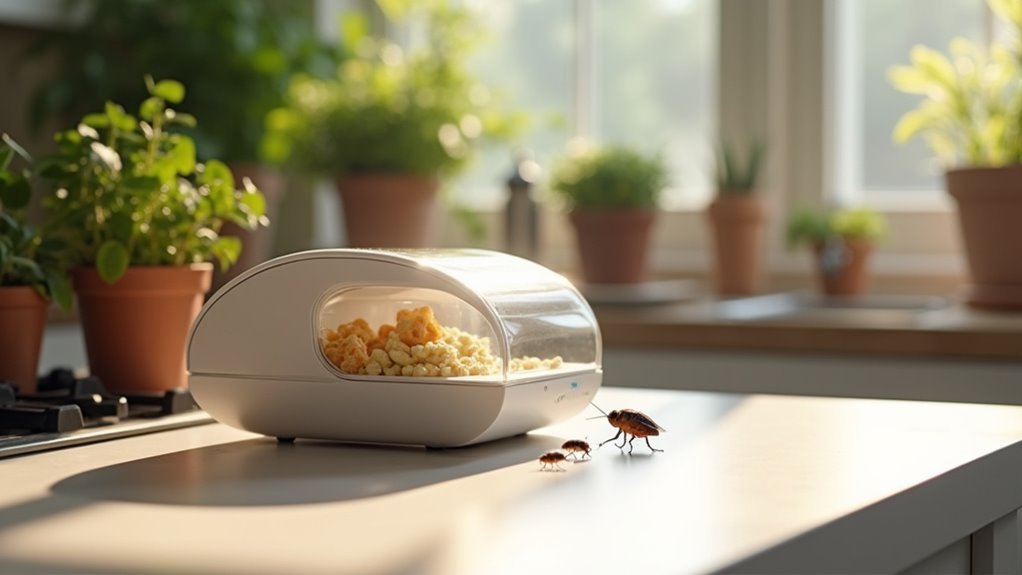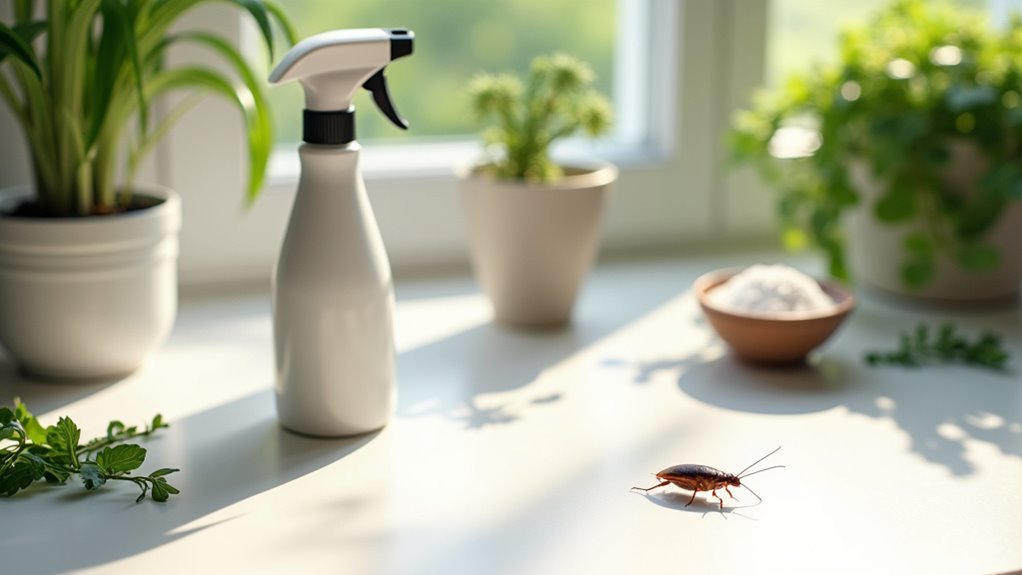Roaches fear these pet-friendly methods because they target their biological weaknesses without harming your family. Essential oils like peppermint and eucalyptus overwhelm their sensory receptors, disrupting navigation and creating confusion. Diatomaceous earth damages their exoskeletons, causing fatal dehydration, while catnip’s nepetalactone interferes with their sensory perception. Vinegar masks the pheromones they need for communication, and cinnamon disrupts their ability to locate food sources. Understanding these vulnerabilities helps you choose the most effective natural approaches.
Natural Ingredients That Disrupt Cockroach Sensory Systems

When you’re dealing with cockroaches but can’t risk harming your pets, natural ingredients offer a powerful solution by targeting roaches’ highly sensitive sensory systems.
Essential oils like peppermint and eucalyptus overwhelm their sensory receptors with strong scents, making your home less hospitable. Cinnamon disrupts their olfactory senses, preventing them from maneuvering and finding food sources effectively.
Diatomaceous earth provides exceptional pet-safe roach control by physically damaging their exoskeletons, causing fatal dehydration without toxic chemicals.
Catnip’s nepetalactone compound interferes with their sensory perception when strategically placed around problem areas. Vinegar masks the pheromones cockroaches depend on for communication and maneuvering.
These natural repellents work by exploiting cockroaches’ reliance on their sensory systems, creating an environment they’ll actively avoid while keeping your pets completely safe.
Diatomaceous Earth: The Pet-Safe Desiccant That Roaches Fear
While essential oils and other natural repellents create barriers that deter cockroaches, diatomaceous earth takes a more direct approach by physically destroying these pests from the inside out.
Unlike repellents that simply deter pests, diatomaceous earth physically eliminates cockroaches by damaging their protective exoskeletons and causing fatal dehydration.
This pet-safe fossilized algae powder works as one of the most effective control methods available to homeowners. When cockroaches contact DE, it damages their exoskeletons, causing rapid dehydration and death within days.
You’ll appreciate that diatomaceous earth ranks among the safest natural deterrents for homes with pets.
Apply it in dry areas where roaches travel, but keep it away from pet access points to prevent respiratory irritation. Unlike harsh chemicals, this sustainable solution will eliminate cockroaches gradually over 1-3 weeks without threatening your furry family members’ health.
Essential Oils and Their Repellent Properties Against Cockroaches

You’ll find that rosemary oil offers powerful cockroach-repelling properties while remaining completely safe for your pets to be around.
The nepetalactone compound found in certain essential oils creates an invisible barrier that cockroaches can’t tolerate, forcing them to seek shelter elsewhere.
When you apply these oils correctly using pet-safe methods, you’re creating a natural defense system that protects your home without endangering your furry family members.
Rosemary Oil Benefits
Although synthetic pesticides dominate the market, rosemary oil offers a powerful natural alternative that’s both effective against cockroaches and safe for your furry family members.
This pet-safe essential oil contains compounds like 1,8-cineole and alpha-pinene that disrupt cockroaches’ sensory receptors, creating confusion and driving them away from treated areas.
You’ll find rosemary oil particularly valuable because it doesn’t just mask odors—it actively creates an environment roaches find inhospitable.
The scent acts as a natural barrier, considerably reducing cockroach activity and survival rates in your home.
Unlike harsh chemicals, these natural pest control solutions won’t harm your pets or family when properly diluted.
Regular application in entry points helps repel roaches while maintaining a safe living environment for everyone.
Nepetalactone Compound Effects
One compound stands out among natural cockroach deterrents: nepetalactone, the active ingredient that gives catnip its distinctive properties. This natural repellent disrupts cockroaches’ sensory perception and navigation abilities through their chemoreceptors. When cockroaches detect nepetalactone’s strong scent, they perceive it as a threat and avoid treated areas entirely.
| Nepetalactone Benefits | Application Method |
|---|---|
| Disrupts roach navigation | Diluted essential oil spray |
| Non-toxic to pets | Direct catnip placement |
| Triggers avoidance response | Diffuser aromatherapy |
| Safe pest management strategy | Powder application |
| Chemical-free solution | Cotton ball saturation |
You’ll find this pet-safe compound creates an unfavorable environment for cockroaches without exposing your family to harmful pesticides. By incorporating nepetalactone into your pest management strategy, you’re choosing an effective, natural approach that protects both your home and beloved pets.
Safe Application Methods
When you’re ready to implement essential oils as your primary cockroach defense, proper application methods guarantee maximum effectiveness while keeping your pets completely safe.
Create DIY roach sprays by mixing ten drops of peppermint, lavender, or eucalyptus oil with water in a spray bottle. Focus on entry points, baseboards, and areas where you’ve spotted cockroach activity. These safe application methods assure you’ll repel cockroaches without exposing your pets to harmful chemicals.
You can also use diffusers to maintain consistent coverage throughout your home. Place cotton balls soaked in essential oils near potential hiding spots. This pet-safe approach creates an inhospitable environment that cockroaches actively avoid.
Reapply these natural repellents every few days to maintain their potency and continue deterring infestations effectively.
Innovative Trap Designs That Outsmart Roach Behavior

You can outsmart cockroaches by understanding their behavioral patterns and exploiting them through strategic trap placement.
Smart bait placement targets their preferred travel routes along walls and dark corners, while positioning traps away from your pets’ reach guarantees safety.
Multi-catch designs maximize your success by capturing several roaches at once, taking advantage of their tendency to follow pheromone trails left by other cockroaches.
Smart Bait Placement Strategies
Since cockroaches follow predictable patterns and behaviors, smart bait placement strategies can dramatically improve your pest control success while keeping your furry friends safe.
You’ll achieve maximum results by positioning traps along roaches’ commonly traveled routes, such as behind appliances and under sinks where they naturally seek dark, confined spaces.
Effective traps require strategic positioning in high-traffic areas where cockroaches are most likely to encounter them.
You can enhance your pet-safe methods by using attractive lures like food-based baits or pheromone attractants that entice roaches without harming your pets.
Remember to regularly relocate your traps based on observed cockroach behavior patterns, as these pests may adapt to stationary placements over time, reducing overall effectiveness.
Multi-Catch Design Advantages
Multi-catch traps represent a significant advancement in pet-safe pest control, building on strategic placement by incorporating innovative designs that exploit cockroach psychology.
These roach control devices feature unique entry points that allow multiple cockroaches to enter while preventing escape through clever engineering.
You’ll find these non-toxic traps utilize powerful attractants like food-based lures or pheromones that capitalize on roaches’ natural foraging instincts.
The enclosed design minimizes predator exposure, addressing cockroaches’ inherent fear of open spaces.
Sticky surfaces and confined chambers take advantage of their erratic movement patterns, ensuring quick capture.
What makes multi-catch traps particularly effective is their dual benefit: they’re completely pet-safe while maximizing catch rates, giving you powerful pest control without compromising your family’s safety.
Gel Baits: Targeted Elimination Without Pet Exposure Risks
When dealing with cockroach infestations in homes with pets, gel baits offer a strategic solution that targets pests while minimizing exposure risks to your furry companions.
These pet-safe formulations contain active ingredients like indoxacarb that disrupt cockroaches’ nervous systems for targeted elimination. Unlike sprays and powders, gel baits don’t create airborne irritants, making them safer alternatives for households with sensitive pets.
You’ll appreciate that these baits are strategically designed with gel consistency and placed in areas your pets can’t access, reducing accidental ingestion risks.
Cockroaches consume the bait, return to their hiding spots, and die within 3 to 7 days. This approach eliminates visible pest populations without exposing your pets to harmful residues throughout your home.
Catnip and Nepetalactone: Nature’s Roach Deterrent
Beyond synthetic solutions, nature provides its own powerful weapon against cockroaches through catnip and its active compound, nepetalactone. This pet-safe roach deterrent works by interfering with roaches’ sensory perception, making treated areas less attractive to them. You’ll find nepetalactone acts as a natural insect repellent that’s non-toxic for both pets and humans.
| Application Method | Effectiveness Level |
|---|---|
| Dried catnip sachets | Moderate deterrent |
| Fresh catnip leaves | High initial impact |
| Nepetalactone oil spray | Maximum concentration |
| Combined with cleaning | Enhanced results |
| Standalone treatment | Limited long-term effect |
While this pest control method works temporarily, you’ll maximize results by combining catnip with other strategies like sealing entry points. Remember, not all roach species respond equally to this natural deterrent.
Strategic Application Techniques for Maximum Effectiveness
Although natural roach deterrents offer pet-safe alternatives, you’ll achieve the best results only when you apply them strategically throughout your home.
Place cinnamon and catnip in high-traffic areas where roaches commonly travel to disrupt their sensory navigation. Apply food-grade diatomaceous earth in cracks and crevices, creating effective barriers they can’t easily cross.
Target roach pathways with cinnamon and catnip while using diatomaceous earth to seal entry points and create impenetrable natural barriers.
Use glue traps with pet-safe baits to monitor roach activity without toxic chemicals.
Strategic cleaning combined with essential oils creates an unwelcoming environment while protecting your pets. Regular cleaning enhances these methods’ effectiveness by removing food sources that attract roaches.
Remember to refresh natural repellents frequently, as scents dissipate over time.
Combining multiple pet-friendly approaches maximizes your success rate against these persistent pests.
Behavioral Insights: Why These Methods Exploit Roach Weaknesses
Understanding why pet-friendly roach control methods work so effectively requires examining the specific biological and behavioral weaknesses these approaches target.
You’re exploiting cockroaches’ heightened sensitivity to strong scents when using natural repellents like cinnamon and essential oils, which disrupt their navigation and communication systems. Their erratic escape mechanisms become disadvantages when you deploy sticky traps that capitalize on their rapid movements.
Most cockroach species can’t survive in dry environments, making diatomaceous earth particularly lethal as it dehydrates them. You’re also targeting their vulnerable molting process with natural IGRs that prevent reproduction.
These pet-friendly solutions work precisely because they’re safe and effective, using physical properties rather than toxic chemicals to exploit roaches’ fundamental biological limitations.
Frequently Asked Questions
What Are Cockroaches Most Afraid Of?
You’ll find cockroaches most afraid of strong scents like peppermint and eucalyptus oils, natural predators such as cats, diatomaceous earth’s dehydrating properties, sudden movements or sounds, and repellent spices like cinnamon.
What Is the Best Pet Friendly Way to Get Rid of Roaches?
You’ll get best results using cockroach gel baits combined with food-grade diatomaceous earth. These target roaches’ biology directly while staying safe for pets. Add regular cleaning and seal entry points to prevent future infestations effectively.
Why Do Roaches Run Towards You?
Roaches run towards you because they’re startled by your sudden movements and instinctively flee toward perceived safety. Their erratic flight response makes them seem like they’re chasing you when they’re actually escaping.
Why Should You Not Squish a Cockroach?
You shouldn’t squish cockroaches because it releases pheromones that attract more roaches, spreads bacteria they carry, and doesn’t effectively eliminate them due to their resilient exoskeleton protecting them.
In Summary
You’ve discovered why roaches can’t stand these pet-friendly methods—they’re designed to exploit fundamental cockroach vulnerabilities. You’re targeting their sensory systems with natural ingredients, disrupting their navigation with essential oils, and using their own behavioral patterns against them. These approaches don’t just repel; they actively interfere with roaches’ survival mechanisms. You’re not compromising your pets’ safety while effectively eliminating these persistent pests through scientifically-backed, nature-derived solutions.





Leave a Reply